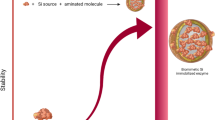Abstract
Spherical micro silica sol-gel immobilized enzyme beads were prepared in an emulsion system using cyclohexanone and Triton-X 114. The beads were used for thein situ immobilization of transaminase, trypsin, and lipase. Immobilization during the sol to gel phase transition was investigated to determine the effect of the emulsifying solvents, surfactants, and mixing process on the formation of spherical micro sol-gel enzyme beads and their catalytic activity. The different combinations of sol-gel precursors affected both activity and the stability of the enzymes, which suggests that each enzyme has a unique preference for the silica gel matrix dependent upon the characteristics of the precursors. The resulting enzyme-entrapped micronsized beads were characterized and utilized for several enzyme reaction cycles. These results indicated improved stability compared to the conventional crushed form silica sol-gel immobilized enzyme systems.
Similar content being viewed by others
References
Tischer, W. and F. Wedekind (1999) Immobilized enzymes: Methods and applications.Top. Curr. Chem. 200: 95–126.
Prakash, O. and L. S. B. Upadhyay (2006) Immobilization imparts stability to watermelon urease.Biotechnol. Bioprocess Eng. 11: 140–145.
Kim, J., C.-S. Lee, J. Oh, and B. G. Kim (2001) Production of egg yolk lysolecithin with immobilized phospholipase A2 Enzyme Microb. Technol. 29: 587–592.
Seo, W.-Y. and K. Lee (2004) Optimized conditions forin situ immobilization of lipase in aldehyde-siliica packed columns,Biotechnol. Bioprocess Eng. 9: 465–470.
Wang, T.-H. and W.-C. Lee (2003) Immobilization of proteins on magnetic nanoparticles.Biotechnol. Bioprocess Eng. 8: 263–267.
Gill, I. and A. Ballesteros (2000) Bioencapsulation within synthetic polymers (Part I): sol-gel encapsulated biologicals.Trends Biotechnol. 18: 282–296.
Gill, I. and A. Ballesteros (2000) Bioencapsulation within synthetic polymers (Part II): non-sol-gel protein-polymer biocomposites.Trends Biotechnol. 18: 469–479.
Kim, J. B., R. Delio, and J. S. Dordick (2002) Protease-containing silicates as active antifouling materialsBiotechnol. Prog. 18: 551–555.
Jin, W. and J. D. Brennan (2002) Properties and applications of proteins encapsulated within sol-gel derived materials.Anal. Chim. Acta 461: 1–36.
Livage, J. (1997) Sol-gel processes.Curr. Opin. Solid State Mater. Sci. 2: 132–138.
Vidoto, E. A., F. S. Vinhado, M. S. M. Moreira, O. R. Nascimento, Y. Iamamoto, and K. J. Ciuffi (2002) Immobilization of beta halogenated ironporphyrin in the silica matrix by the sol-gel process.J. Non-Cryst. Solids 304: 151–159.
Reetz, M. T., A. Zonta, and J. Simpelkamp (1995) Efficient heterogeneous biocatalysts by entrapment of lipases in hydrophobic sol-gel materials.Angew. Chem. Int. Ed. Engl. 34: 301–303.
Reetz, M. T., A. Zonta, and J. Simpelkamp (1996) Efficient immobilization of lipases by entrapment in hydrophobic sol-gel materials.Biotechnol. Bioeng. 49: 527–534.
Gill, I., and A. Ballesteros (1998) Encapsulation of biologicals within silicate, siloxane, and hybrid sol-gel polymers: An efficient and generic approach.J. Am. Chem. Soc. 120: 8587–8598.
Chen, Q., G. Kenausis, and A. Heller (1998) Stability of oxidases immobilized in silica gels.J. Am. Chem. Soc. 120: 4582–4585.
Schuleit, M., and P. L. Luisi (2001) Enzyme immobilization in silica-hardened organogels.Biotechnol. Bioeng. 72: 249–253.
Lobnik, A., and M. Cajlakovic (2001) Sol-gel based optical sensor for continuous determination of dissolved hydrogen peroxide.Sens. Actuators B 74: 194–199.
Bharathi, S., and O. Lev (2000) Sol-gel-derived prussian blue-silicate amperometric glucose biosensor.Appl. Biochem. Biotechnol. 89: 209–216.
Williams, A. K., and J. T. Hupp (1998) Sol-gel-encapsulated alcohol dehydrogenase as a versatile, environmentally stabilized sensor for alcohols and aldehydes.J. Am. Chem. Soc. 120: 4366–4371.
Ramanathan, K., B. Rees-Jönsson, and B. Danielsson (2001) Sol-gel based thermal biosensor for glucose.Anal. Chim. Acta 427: 1–10.
Lee, W.-Y., K. S. Lee, T.-H. Kim, M.-C. Shin, and J.-K. Park (2000) Microfabricated conductometric urea biosensor based on sol-gel immobilized urease.Electroanalysis 12: 78–82.
Iskandar, F., Mikrajuddin, and K. Okuyama (2001)In situ production of spherical silica particles containing self-organized mesopores.Nano Lett. 1: 231–234.
Adachi, K., T. Iwamura, and Y. Chujo (2004) Novel synthesis of submicrometer silica spheres in non-alcoholic solvent by microwave-assisted sol-gel method.Chem. Lett. 33: 1504–1505.
Lee, C.-M., S. Lim, G.-Y. Kim, D. Kim, D.-W. Kim, H.-C. Lee, and K.-Y. Lee (2004) Rosin microparticles as drug carriers: Influence of various solvents on the formation of particles and sustained-release of indomethacin.Biotechnol. Bioprocess Eng. 9: 476–481.
Matsumoto, T., Y. Takayama, N. Wada, H. Onoda, K. Kojima, H. Yamada, and H. Wakabayashi (2003) Acid-free synthesis of poly-organo-siloxane spherical particles using a W/O emulsion.J. Mater. Chem. 13: 1764–1770.
Barbé, C. J. A. and J. Barlett (2001) Controlled release ceramic particles, compositions thereof, processes of preparation and methods of use. WO0162232.
Bush, A. J., R. Beyer, R. Trautman, C. J. Barbé, and J. R. Bartlett (2004) Ceramic micro-particles synthesized using emulsion and sol-gel technology: An investigation into the controlled release of encapsulants and the tailoring of micro-particle size.J. Sol-Gel Sci. Technol. 32: 85–90.
Barbé, C. J., J. Bartlett, L. Kong, K. Finnie, H. Q. Lin, M. Larkin S. Calleja, A. Bush, and G. Calleja (2004) Silica particles: A novel drug-delivery system.Adv. Mater. 16: 1959–1966.
Shin, J. S., and B. G. Kim (1998) Kinetic modeling of omega-transamination for enzymatic kinetic resolution of alpha-methylbenzylamine.Biotechnol. Bioeng. 60: 534–540.
Shin, J. S., and B. G. Kim (1996) Optical resolution of racemic 1-phenylethylamine catalyzed by aminotransferase and dehydrogenase.Ann. N. Y. Acad. Sci. 799: 717–724.
O'Connell, P. J., and J. Varley (2001) Immobilization ofCandida rugosa lipase on colloidal gas aphrons (CGAs).Biotechnol. Bioeng. 74: 264–269.
Nouaimi, M., K. Möschel, and H. Bisswanger (2001) Immobilization of trypsin on polyester fleece via different spacers.Enzyme Microb. Technol. 29: 567–574.
Author information
Authors and Affiliations
Corresponding author
Rights and permissions
About this article
Cite this article
Lee, Cw., Yi, SS., Kim, J. et al. Improved immobilized enzyme systems using spherical micro silica sol-gel enzyme beads. Biotechnol. Bioprocess Eng. 11, 277–281 (2006). https://doi.org/10.1007/BF03026240
Received:
Accepted:
Issue Date:
DOI: https://doi.org/10.1007/BF03026240




